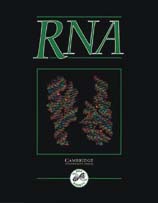Position-dependent inhibition of the cleavage step of pre-mRNA 3′-end processing by U1 snRNP
Published online by Cambridge University Press: 01 February 2000
Abstract
The 3′ ends of most eukaryotic pre-mRNAs are generated by 3′ endonucleolytic cleavage and subsequent polyadenylation. 3′-end formation can be influenced positively or negatively by various factors. In particular, U1 snRNP acts as an inhibitor when bound to a 5′ splice site located either upstream of the 3′-end formation signals of bovine papilloma virus (BPV) late transcripts or downstream of the 3′-end processing signals in the 5′ LTR of the HIV-1 provirus. Previous work showed that in BPV it is not the first step, 3′ cleavage, that is affected by U1 snRNP, but rather the second step, polyadenylation, that is inhibited. Since in HIV-1 the biological requirement is to produce transcripts that read through the 5′ LTR cleavage site rather than being cleaved there, this mechanism seemed unlikely to apply. The obvious difference between the two examples was the relative orientation of the 3′-end formation signals and the U1 snRNP-binding site. In vitro assays were therefore used to assess the effect of U1 snRNP bound at various locations relative to a cleavage/polyadenylation site on the 3′ cleavage reaction. U1 snRNP was found to inhibit cleavage when bound to a 5′ splice site downstream of the cleavage/polyadenylation site, as in the HIV-1 LTR. U1 snRNP binding at this location was shown not to affect the recruitment of multiple cleavage/polyadenylation factors to the cleavage substrate, indicating that inhibition is unlikely to be due to steric hindrance. Interactions between U1A, U1 70K, and poly(A) polymerase, which mediate the effect of U1 snRNP on polyadenylation of other pre-mRNAs, were shown not to be required for cleavage inhibition. Therefore, U1 snRNP bound to a 5′ splice site can inhibit cleavage and polyadenylation in two mechanistically different ways depending on whether the 5′ splice site is located upstream or downstream of the cleavage site.
Information
- Type
- Research Article
- Information
- Copyright
- 2000 RNA Society
- 56
- Cited by

